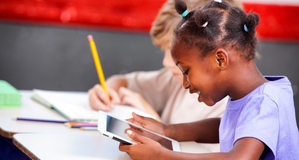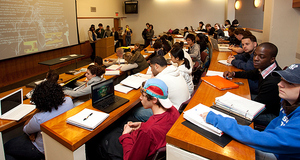Incorporating Technology into the Modern English Language Arts Classroom
By
2011, Vol. 3 No. 01 | pg. 1/2 | »
KEYWORDS:
The mere mention of the English Language Arts content area, for many people, might conjure images of ancient, dusty tomes, the sound of a classroom full of pens scratching across college-ruled paper, or the palpable befuddlement of students staring down a school year full of challenging texts and writing. Enter technology, and along with it an entirely new skill set and accompanying literacies. This is the twenty-first century after all, and English teachers would be remiss if they did not take advantage of the latest and greatest technological methods of reading, expression, and communication. Alvermann (2007) points out the irony in many of today's curricular standards and teaching practices, which shy away from those technologies and literacies, opting for a push toward more traditional approaches at a time when our digitally native students are immersed in and engaging with "multiple sign systems (image, print, sound, gesture, digital) and finding their own reasons for becoming literate" (p. 19). Fear not, fellow English teachers, for it is possible to embrace those technologies and address those modern skills and literacies in ways that still maintain focus on state and district standards, all while piquing student interest and bolstering motivation and collaboration. It's only a matter of finding creative ways to incorporate technology, or simply putting an updated, modern spin on typical assessments and activities. Gainer and Lapp (2010) put an interesting "spin" on conceptualizing the process of reading, comprehending, and writing. In their view, the student is an active participant in this process, drawing their own meaning from texts according to their own perspectives and prior knowledge, and they blend their experiences and knowledge with new information drawn from the text, expressing their new understanding through "remix" (p. 58). This is a process that has always been prevalent in the English classroom, as students read and interpret works, draw on prior knowledge and the work of others, and then blend information and understanding into a new, original text.Applied to a specific author, or texts, Literary Remix challenges students to use digital tools to make connections between the texts and their social and historical contexts. Gainer and Lapp present a lesson, in which students make connections between works by Zora Neale Hurston and Langston Hughes, and the racial issues that were prominent in the 1920s and those that still persist today. Using questions and findings from their reading of the works, the students use a software program called Comic Life to create a fictional, comic-book-style dialogue between themselves and one of the authors (Gainer & Lapp, 2010, p. 60). This type of activity engages students in reading and understanding challenging texts, while relying on their computer skills and creativity to demonstrate higher order understanding of the texts, authors, and relationships to society and history by composing their own text. With the advent of the World Wide Web, and sites and software that promote the creation of user-sourced content and communication (Facebook, Twitter, YouTube), the remixing practice has transcended the classroom, becoming a daily life activity for students. According to one teacher interviewed for this article, "[because] students in our classrooms are millennial learners, they constantly rely on technology for communication and social interaction outside of the classroom" (Mr. B., personal communication, November 16, 2010). Through the use of digital tools, students can easily mix text, sound, video, and images, to create an original, multimodal text (Gainer & Lapp, 2010, p. 59). Use of technology outside of the classroom is not an issue to contend with, but one to embrace and bring into the classroom. Tarasiuk's (2010) discussion of contemporary literacy follows this same theme, beginning with how she began to learn about and understand her students' uses of technology for creation and communication outside of the classroom. She pointed out one student in particular, who was a struggling reader in her class. He was unmotivated, bored, and disorganized, and scored below level on state and local assessments. Tarasiuk found, however, that this student was leading a sort of double life; outside of the classroom, he was designing websites and composing and editing videos of himself and his friends, which he prolifically posted to his YouTube channel. Some of these videos, while immature in subject matter, demonstrated essences of literary understanding, and of successful reading, planning, and writing (p. 543). Today's adolescents are digital natives, with a broader definition of literacy as a collection of contemporary activities involving information and communication technology (ICT), as opposed to the traditional definition as paper and ink texts and writing. Tarasiuk addresses these varying mindsets in her classroom by finding ways to incorporate ICT instruction into her curriculum. She began this process by surveying the students, in order to measure their traditional and modern literacy practices. She found that her students, even the strugglers, were adept Internet users whom enjoyed reading traditional materials while simultaneously looking for additional information, sharing their information, or communicating with peers online (p. 547). Tarasiuk was able to use her survey results to make modifications in her lessons and assessments that would incorporate ICT and bolster student motivation and interest. Replacing traditional worksheets and packets with wikis was one strategy she used to encourage student synthesis of content and collaboration. As students read, they collaborated to "organize information about vocabulary, summaries, and characterization" and add that information to their wiki pages (p. 547-548). Posted openly on the Internet, the use of wikis transitioned students from completing worksheets for their own use to creating polished, public content, which is accessible by anyone on the Web. The public nature of the resulting work motivated students to invest significantly more effort than they previously had in completing traditional notes and packets. This use of wikis offers an example of how technology can be incorporated in the classroom through authentic work, while still maintaining focus on standards and traditional curricular materials. Harnessing the already-established practice of remixing and using ICT in the classroom might take other forms, such as informal writing exercises, or video montages that blend classics with a contemporary twist. Aronson (2010) discusses the use of informal writing through a series of text messages between two characters. The use of imaginary, informal "text messages" between Romeo and Juliet enables students to engage, and better understand, Shakespeare's challenging language using contemporary literacies that they bring in from outside the classroom (p. 7). A majority of secondary-level students are familiar with some form of instant communication such as texting, instant messaging, or authoring posts on Facebook friends' "Walls." Aronson's example is one that doesn't necessitate the presence of digital technology in the classroom, but still addresses modern literacies and traditional texts by using modern formats for written communication. Video montage provides similar benefits, but makes use of software like Photo Story and iMovie, or a website such as Animoto.com. During my observations at a local middle school, I had the opportunity to work with eighth-grade students as they created projects on Photo Story and using the online tools from Animoto. After reading Avi's Nothing but the Truth, students worked individually to research and create a propaganda piece supporting a fictional product, political figure, or organization, using images from the Internet and Photo Story. Although they were working on individual projects, many of the students naturally collaborated, sharing ideas and suggestions. The final product was a polished slideshow, complete with a soundtrack and a scripted, self-recorded voice-over, narrating the clip. The Animoto project was similar, but tasked students with creating a thirty-second movie trailer to promote one of the several Edgar Allen Poe short stories they had previously read in class. Students scoured the Internet for images and music to use, and then used Animoto's free video publishing tools to assemble a trailer that successfully conveyed the themes and moods of the short story - without spoiling the ending, of course. The teacher at the school stressed the importance of using technology to motivate students and hold their interest, noting a significant increase in both motivation and interest whenever technology was integrated. He did, however, offer a caveat regarding collaboration, indicating that unclear expectations and directions might allow student collaborators to stray off topic (Mr. B., personal communication, November 16, 2010). A second teacher interviewed for this article also indicated a spike in motivation and interest when technology is integrated into a lesson or activity, but also warns that savvy students might lose interest if the materials are not challenging enough, or "dumbed down" (Ms. L., personal communication, November 12, 2010). Ultimately, the use of remix and ICT in the classroom has great potential for student benefit, but the focus tends to remain on the traditional texts as the content, with the technology and literacies that accompany it being used to achieve the goal of developing new forms of expression, designing unique activities and assessments, and building a sense of community in the classroom. Building a classroom community and reaching out of the class into the school, or even the community at large, is significant benefit of technology in class. Davis and Davis (2005) discuss the use of lessons that enable students to be authors of digital texts, which allow them to connect with their peers and the greater community (p. 36). As teachers, they use web development and graphics software to enable students to create public, oral history projects, which they share with classmates. The projects are focused on course content and use the Web to publish student work and to create a forum for online student conferencing. Such publicized work, and the collaborative process of supportive conferencing and synthesis promote a tremendous sense of community in the class and among participants in the project. Students begin by researching one of a number of content-related topics in order to gain an understanding of their subject. They then set out to interview a family member, or a member of the community, about that subject. With the background knowledge provided by the preliminary research, students go into the interview process prepared and confident in their knowledge of the subject.Continued on Next Page » Suggested Reading from Inquiries Journal
Inquiries Journal provides undergraduate and graduate students around the world a platform for the wide dissemination of academic work over a range of core disciplines. Representing the work of students from hundreds of institutions around the globe, Inquiries Journal's large database of academic articles is completely free. Learn more | Blog | Submit Latest in Education |


















